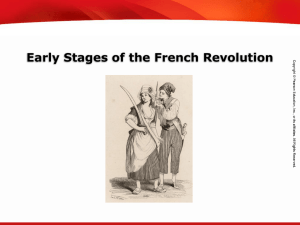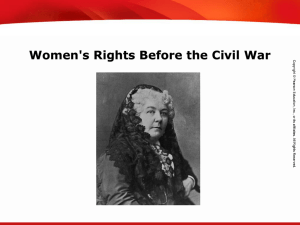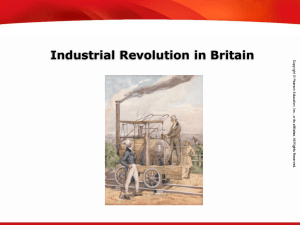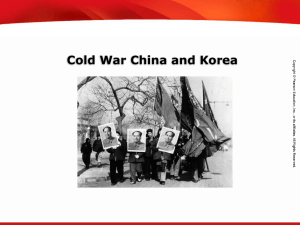7.4 PPT - Robbinsville Public School District
advertisement
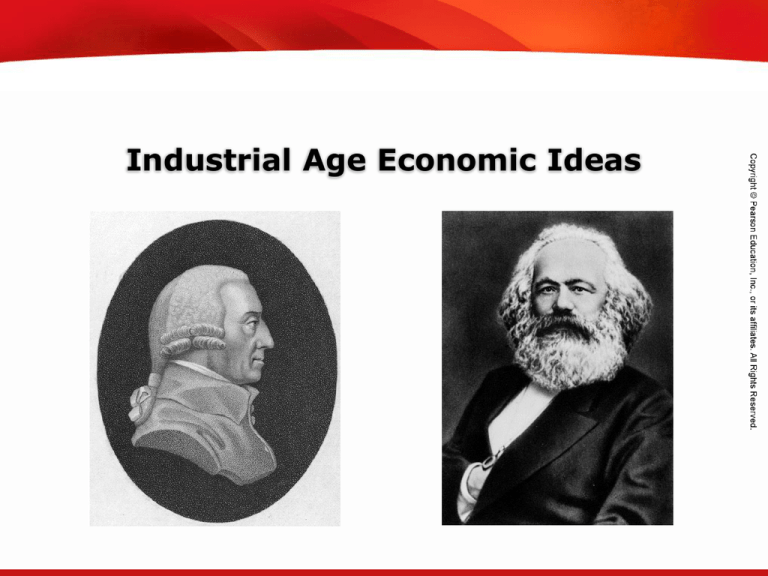
TEKS 8C: Calculate percent composition and empirical and molecular formulas. Industrial Age Economic Ideas TEKS 8C: Calculate percent composition and empirical and molecular formulas. Objectives • Understand laissez-faire economics and the beliefs of those who supported it. • Describe the doctrine of utilitarianism. • Summarize the theories of socialism. • Explain Marx’s views of the working class and responses to Marxism. TEKS 8C: Calculate percent composition and empirical and molecular formulas. Terms and People • Thomas Malthus – British economist; wrote An Essay on the Principles of Population warning that the population would outgrow the food supply • Jeremy Bentham – British philosopher and economist who advocated utilitarianism • utilitarianism – the idea that the goal of society should be “the greatest happiness for the greatest number of citizens,” and that this should be the basis for judging all laws TEKS 8C: Calculate percent composition and empirical and molecular formulas. Terms and People (continued) • socialism – the belief that the means of production should be owned and operated by and for the people in general rather than by and for private individuals • means of production – farms, factories, railways, mines, and other large businesses that produce and distribute goods • Robert Owen – a Utopian who set up a model community at his cotton mill in Scotland TEKS 8C: Calculate percent composition and empirical and molecular formulas. Terms and People (continued) • Karl Marx – German philosopher who, with Frederick Engels, published The Communist Manifesto predicting class struggle • communism – in practice, a system in which a small elite controlled the political and economic life of a nation • proletariat – society’s “have nots,” the working class • social democracy – a political ideology favoring gradual transition from capitalism to socialism TEKS 8C: Calculate percent composition and empirical and molecular formulas. What new ideas about economics and society were fostered as a result of the Industrial Revolution? Economic thinkers developed new ideas and ideologies to explain the staggering changes of the Industrial Age. While some focused on the benefits of the free operation of capitalism, others looked at the harsh conditions faced by workers. TEKS 8C: Calculate percent composition and empirical and molecular formulas. Enlightenment economic thinkers believed that natural laws govern the world of business and economics. They believed these laws should be allowed to operate without any government interference. This attitude of keeping “hands off” was called “laissez faire.” TEKS 8C: Calculate percent composition and empirical and molecular formulas. Most famous of these thinkers was Adam Smith, who published The Wealth of Nations in 1776. • Most middle-class capitalists agreed with Smith’s laissezfaire approach to capitalism. • Supporters of free-market capitalism saw the success of the industrial age, in which government played no part, as evidence for laissez faire. TEKS 8C: Calculate percent composition and empirical and molecular formulas. Thomas Malthus was an English economist who carefully studied the impact of the population explosion in eighteenth-century Britain. He concluded that poverty was unavoidable because the population was growing faster than the nation’s ability to grow food. TEKS 8C: Calculate percent composition and empirical and molecular formulas. Malthus said that unless the working class had fewer children, they were doomed to remain in poverty. He felt that “natural events” such as famine or war were the only mechanisms to maintain a sustainable population. Many agreed with Malthus, but he proved to be wrong. Food production rose quickly over the next century. TEKS 8C: Calculate percent composition and empirical and molecular formulas. Another British laissez-faire economist was David Ricardo. Like Malthus, Ricardo saw no hope for the working class to escape poverty. Ricardo opposed help for the poor, contending that this would only lead them to have more children. Malthus and Ricardo saw the “laws of the free market” as the best cure for poverty and advised the poor to be thrifty, work hard, and have fewer children. TEKS 8C: Calculate percent composition and empirical and molecular formulas. Other thinkers, such as Jeremy Bentham, believed there should be some government intervention in the economy. Bentham believed that the goal of society should be “the greatest happiness for the greatest number of citizens.” This idea was called utilitarianism. Laws should be judged by their utility to benefit people. TEKS 8C: Calculate percent composition and empirical and molecular formulas. One follower of Bentham was John Stuart Mill. • Like Bentham and Smith, Mill believed in individual freedom. • But he also believed, “The only purpose for which power can be rightfully exercised over any member of a civilized community, against his will, is to prevent harm to others.” • Mill saw capitalists harming workers. He called for limiting their power to do so by giving workers the right to vote. TEKS 8C: Calculate percent composition and empirical and molecular formulas. The champions of laissez-faire economics praised individual rights, whereas socialists focused on the good of society in general. Capitalism: Individuals should own and operate the means of production for profit. Socialism: The people as a whole should own and operate the means of production for the general good. TEKS 8C: Calculate percent composition and empirical and molecular formulas. Socialists set up communities where work was shared and property was commonly owned. These early socialists were called Utopians. The name implied impractical dreamers. Robert Owen set up a Utopian community at his cotton mill in New Lanark, Scotland. TEKS 8C: Calculate percent composition and empirical and molecular formulas. Owen’s model community was intended to show that mill owners could make a profit and still offer decent wages and conditions. At New Lanark, Owen: • Raised wages • Provided schools • Refused to use child labor • Built homes for workers • Ran a profitable business TEKS 8C: Calculate percent composition and empirical and molecular formulas. German philosopher Karl Marx condemned the ideas of the Utopians as unrealistic idealism. He formulated a new theory that he called “scientific socialism.” TEKS 8C: Calculate percent composition and empirical and molecular formulas. Along with Englishman Frederick Engels, Marx published The Communist Manifesto in 1848. • He predicted a struggle between the social classes that would lead to a classless society. • The workers would take over all of the means of production, such as the farms, factories, and railways, and run them for the public good. TEKS 8C: Calculate percent composition and empirical and molecular formulas. Marx theorized that all of history was a struggle between the “haves” and the “have-nots.” • In industrialized Western Europe, the “haves” were the business owners or bourgeoisie. • The “have-nots” were the workers, or proletariat. • In the end, Marx predicted that the proletariat would unite along class lines, take control of the means of production, and end the struggle. • In practice, Marx’s ideas evolved into communism, a system in which governments led by a small elite controlled all economic and political life. TEKS 8C: Calculate percent composition and empirical and molecular formulas. Marx called for workers everywhere to unite and overthrow the capitalists. • In Germany, socialists adapted Marx’s beliefs to form social democracy, a political ideology calling for a gradual transition from capitalism to socialism. • Russian socialists embraced Marx’s ideas and set up a communistinspired government in 1917. TEKS 8C: Calculate percent composition and empirical and molecular formulas. Revolutionaries around the world adapted Marx to their local goals and needs. But workers worldwide never united as a class. The later failures of communist nations illustrated flaws in Marx’s theories.

